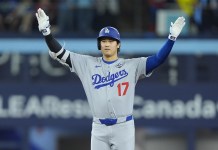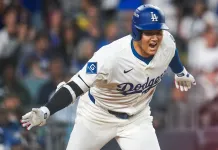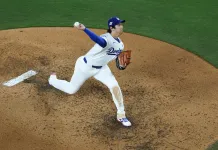The 2021 Seattle Mariners might have been the luckiest team to still miss the playoffs in baseball history.
The Mariners were 90-72 with a run differential of -51. By Pythagorean-Win Loss, they should have been a 76-86 team. They were 33-19 in one-run games, including 14-7 in extra-inning games. They were %plussign% 16 in BaseRuns (74-88), an alternate standings metric that I love to refer to when looking for positive or negative regression. They scored 4.3 runs per game and were fortunate to even do that (BaseRuns had them pegged for 4.17).
Joe Peta’s excellent book, “Trading Bases,” discusses the concept of “cluster luck.” The idea is that a team’s performance with runners in scoring position, on both offense and defense, can have a monumental impact on a team’s record. The Mariners were a prime example.
Overall, the Mariners were 27th in wOBA at .300 and slashed .226/.303/.385. With runners in scoring position, they slashed .259/.338/.450 with a .335 wOBA. With nobody on base, they slashed .211/.287/.367. Teams that get hits at the right times can hide a lot of problems, and the Mariners did precisely that last season.
They would have been a prime fade candidate entering this season if all things were created equal, but GM Jerry Dipoto had exactly the right type of environment for his wheelin’ and dealin’ style heading into 2022.
2022 VSiN MLB Betting Guide
Offense
Dipoto treats his roster like he’s playing “MLB The Show.” If a day goes by without a transaction, he was probably sick or otherwise incapacitated. The expedited offseason created a perfect storm for Dipoto, an aggressive GM that will make his deals quickly and worry about them later.
He made an outstanding trade that deepened the lineup in getting Jesse Winker and Eugenio Suarez from the Reds in exchange for peanuts. With the Adam Frazier acquisition in November and more playing time for Julio Rodriguez and Jarred Kelenic, the Mariners’ offensive profile looks much better. The park factor is still an issue and will suppress the offense to a degree, but the personnel is stronger, even without Kyle Seager, who abruptly retired.
Seager hit 35 home runs but only posted a .308 wOBA and a 99 wRC %plussign% . Those numbers seem doable for Suarez, who had four straight above-average seasons before hitting 31 empty homers with an 85 wRC %plussign% in 2021. Suarez is only 30 and didn’t react well when the Reds moved him to shortstop to start last season.
Winker was the true prize in the deal, though. He goes from an elite hitter’s park in Cincinnati to a stingier one in Seattle, but the 28-year-old has been outstanding the last two years and has had an above-average bat in all five of his MLB seasons. Last year, Winker cut down on the strikeouts and elevated the ball more before a strained side muscle ended his season. He posted a .403 wOBA in 485 plate appearances. The others to post a .400 wOBA in that kind of sample size? Bryce Harper, Juan Soto, Vladimir Guerrero Jr. and Fernando Tatis Jr.
%%offer%%
Alongside Mitch Haniger, who blasted 39 homers and, more importantly, stayed healthy (157 games), the Mariners outfield is in good hands. That statement is especially true if the Mariners let Rodriguez run wild. The 21-year-old has terrorized minor league pitching with elite numbers at every level and a skill set that scouts have raved about for years. The one concern is Rodriguez has never played more than 84 games in a season, so he could wear down, but projection systems already consider his bat well above average at the MLB level. (author's note: Rodriguez has officially made the team)
Kelenic had a rough debut season in 93 games, as he was bad both offensively and defensively. He’s only 22 and hit at every level of the minors, so there’s no reason to rush judgment about his future. He struggled with the transition to MLB pitching, as most guys do, but finished strong with seven homers in 29 September games. Given that he started his MLB career just 8-for-83 at the plate, you have to give him credit for not sulking. He posted a 135 wRC %plussign% in September.
It’s gotten to the point where the Mariners have a bit of a logjam. They have five outfielders for three positions and a DH, as Kyle Lewis returns from a torn meniscus after posting a 107 wRC%plussign% last season. Ty France has first base locked down after putting up a 129 wRC%plussign% in 650 plate appearances last season. We’ll see if the Mariners use the numbers game and financial considerations to keep Rodriguez down in the minors to start the year, but he’ll have an impact at some point.
Seattle got some of the worst production in baseball at second base last season, so they acquired Frazier from the Padres to fill the void. Frazier is a bat-to-ball guy that plays good defense and makes sense at the bottom of the order to turn over the lineup with some chaos on the bases. He doesn’t walk a lot, but he also doesn’t strike out a lot. It creates a BABIP-dependent offensive profile, but one that should play well in this lineup.
All of a sudden, the Mariners lineup looks really good. Rodriguez is the lone homegrown talent, as all of the others were acquired via trade. There are a lot of diverse skills with this group, but most guys have some power potential and are pretty aggressive swingers. The Mariners won’t walk much, so they’ll be reliant on contact quality and the long ball to generate offense.
Pitching
This Mariners pitching staff is likely to be polarizing. Some will really like the construction and some will have a lot of questions. The pitcher-friendly environment at T-Mobile Park hides a lot of warts. The personnel looks better this season, but it’s no coincidence the Mariners are 15th in ERA at home since the start of the 2018 season (4.14) and 26th on the road (4.95).
The big fish for the Mariners is Robbie Ray, who resurrected his career in Toronto and won the 2021 AL Cy Young Award. Ray goes to an ideal park for his home-run problem, as he allowed 33 in 193.1 innings. He’s always had a ton of strikeouts, but he was able to work deeper into games last season by not allowing walks. His 6.7% BB% was the best of his career and his first time in single digits since 2016.
Not only does the park factor improve, but so does the division, as Ray leaves the AL East. There are a lot of reasons to like the sustainability of his improvements. I will say I remain skeptical, as he still allowed a Hard Hit% of 42.9% and a Barrel% of 9.8%. A “barreled ball” has an expected batting average of at least .500 and an expected SLG of at least 1.500. Most “barrels” that go for hits end up doubles or home runs. Ray ranked in the 15th percentile in average exit velocity and 17th in Hard Hit%. If his BB% improvements are not legit, I see him regressing a bit.
The guy I’m more interested in is Logan Gilbert. The big 6-foot-6 right-hander pitched far better than his 4.68 ERA would suggest. He had a 3.73 FIP in 119.1 innings, which is an immediate indicator of positive regression. A big ERA-FIP discrepancy, coupled with a high BABIP and/or a high LOB%, are things I look for with starters. Gilbert’s .293 BABIP was high for an extreme fly-ball guy, and his 67.9% LOB% was low for someone with more than a strikeout per inning.
Gilbert allowed a lot of hard contact as well, which helps to explain the high BABIP. However, Gilbert was awful in August and got back on track in September to finish on a high note. Like Ray, the hard-contact metrics are a concern. He also had problems turning the lineup over, as he struggled badly when turning it over a second and third time.
After Ray and Gilbert, I have some pretty significant concerns about the other starters. Chris Flexen wound up with a 3.61 ERA and a 3.89 FIP in 179.2 innings with some wide home/road splits. Marco Gonzales had a 3.96 ERA but a 5.28 FIP. His command was well below his usual standards. He did have an injury that took away his month of May, and it took him some time to get going. He had a 2.70 ERA in 86.2 innings after the All-Star Break.
Rotation depth is a big worry for the Mariners. Erik Swanson, Justus Sheffield, Nick Margevicius and Matt Brash are in the mix. Some are unproven. Some haven’t pitched well. Injuries will be tough to overcome.
Seattle’s bullpen was light years better than I expected last season and why the team did so well in one-run games. Casey Sadler was third in fWAR but will miss the season with shoulder surgery. Kendall Graveman was fourth before being traded to the Astros. Otherwise, Paul Sewald and Drew Steckenrider are in their prominent roles as closer and setup man.
The Mariners grabbed hard-thrower Diego Castillo from the Rays at last year’s trade deadline and added a reliable vet in Sergio Romo during spring training. They also have former Blue Jays closer Ken Giles, who missed the entire 2021 season but has been a top-notch reliever before.
Player to Watch
OF Julio Rodriguez: My colleague Jason Weingarten wrote about his Rookie of the Year bet on Rodriguez long before the spring training buzz began. The definition of a can’t-miss prospect, Rodriguez has been on top-10 lists each of the last three years and owns a .331/.412/.543 slash in 217 minor league games. Like I said, the Mariners may use the numbers game to justify his salary suppression by keeping him in the minors, but he’s going to represent an upgrade whenever he gets to The Show.
Season Outlook
Seattle was very fortunate to win 90 games last season and outperformed every alternate standings metric by a long shot. I’d be surprised if the bullpen is that good again. I’d also be surprised if the rotation is as good as some people anticipate. They were outscored by 11 runs at home and went 46-35. They were outscored by 40 runs on the road and went 44-37. They were 42-29 in the second half with a -1 run differential. The lineup is what creates a high ceiling for this team. I do think they’re the second-best team in the AL West, but I will have no futures investment in the Mariners. The markets feel a tad optimistic on the season win total, and the Mariners will likely be vying for one playoff spot because the AL East will take at least three of them.
Win Total Lean: Under 83.5





